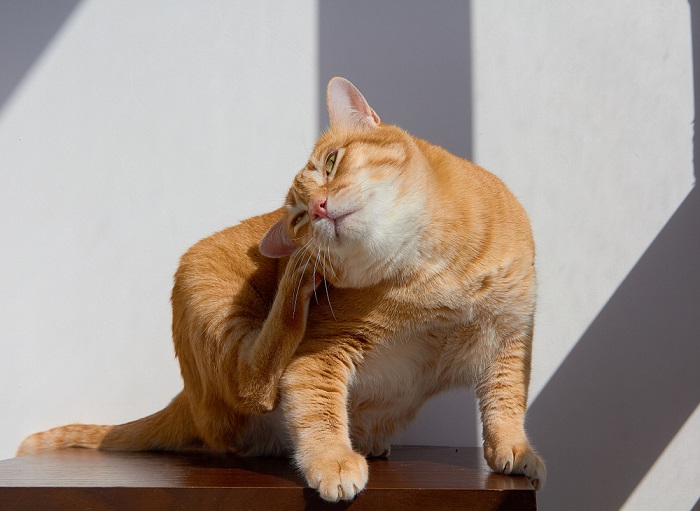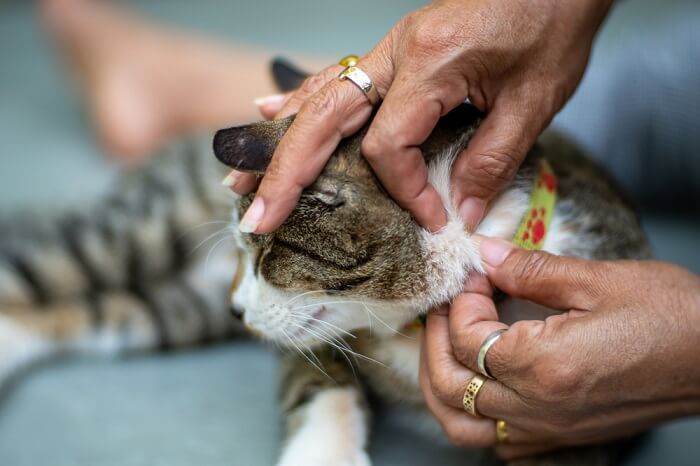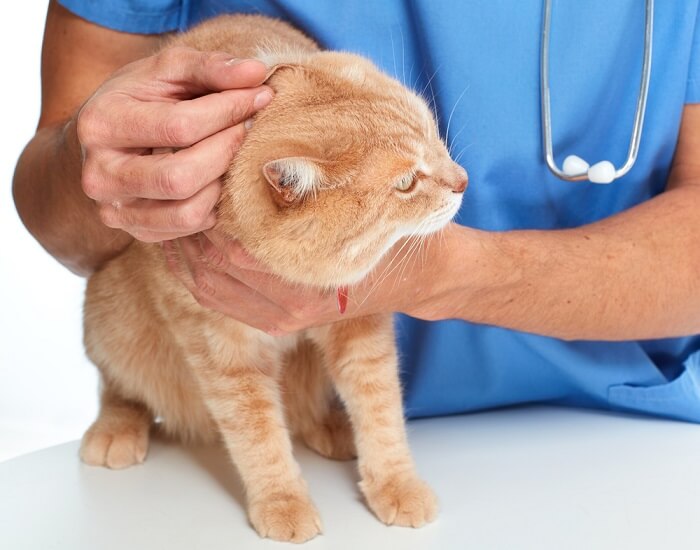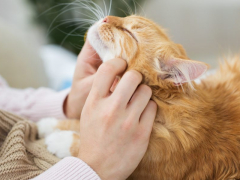
Comfortis for cats is an oral flea product made by Elanco Animal Health in the form of a chewable tablet. It is labeled for killing and preventing the presence of adult fleas and flea infestations.
Comfortis for Cats Overview

In this article, you’ll learn how Comfortis works, potential side effects to look for, dosing information and some frequently asked questions.
About Comfortis for Cats

The active drug in Comfortis is called spinosad. Spinosad is a member of the class of insecticides called spinosyns, which are actually derived from a naturally occurring bacterium called Saccharopolyspora spinosa. This concept is somewhat similar to how the antibiotic penicillin was originally derived from the Penicillium fungal mold.
Spinosyns work by acting on nicotinic acetylcholine D-alpha receptors in the central nervous system of the flea. This leads to muscle contractions and tremors that cause paralysis and death of the flea.
Spinosad has a selectivity for the insect acetylcholine receptors versus similar receptors for vertebrates, like cats. This is part of what confers its level of safety in targeting only fleas.
Comfortis is considered to be effective for 30 days before another dose is needed.
What Does Comfortis Do for Cats?

Comfortis is labeled for killing adult fleas and preventing infestations by killing fleas before they can lay eggs. According to the manufacturer, Comfortis starts killing fleas within 30 minutes with 98% of fleas killed within four hours. Comfortis then continues to work for an entire month.
Comfortis only kills adult fleas and does not have efficacy against flea eggs or larvae, as some other products like Advantage II or Frontline Gold have the ability to do.
As with many flea treatment/prevention products, Comfortis does not provide any repellency against fleas. A flea must bite the skin in order to be killed by the product.
Side Effects of Comfortis for Cats

Comfortis has not been found to interact with any medications in cats, yet some caution has been advised if using with high, extra-label doses of ivermectin.
Fortunately, Comfortis appears to be a very safe product for cats. Limited vomiting a day or two after product administration has been the most commonly reported side effect.
Also Read: Cat Vomiting: Causes, Symptoms, & Treatment
According to the manufacturer, in a study involving about 140 cats treated with Comfortis, about 14% exhibited vomiting either the day of administration or the day after. Only three cats over the three-month, three-dose study showed these signs after every dose.
Other signs seen, which occurred in less than 5% of cats, included lethargy, poor appetite, weight loss and diarrhea.
In cats given up to five times the upper end of the therapeutic dose of Comfortis for a six-month study period, signs of vomiting were seen, but this did not increase in frequency with increased dosages. Loose stool was also seen more often. No laboratory parameters were affected and no other significant effects were seen.
In studies, safe use of Comfortis was also demonstrated when it was given with some other common veterinary medications including dewormers and antibiotics. Some caution has been advised if using with high, extra-label doses of ivermectin. Comfortis has not been found to interact with any other medications in cats.
Safety use of Comfortis has not been established for pregnant or lactating queens, and should be avoided or used cautiously.
If you have any concerns for potential toxicity resulting from use of Comfortis or any medication, it is always best to contact your veterinarian, the ASPCA Animal Poison Control Center (1-888-426-4435) or Pet Poison Helpline (1-855-764-7661) for further advice.
Comfortis for Cats Dosage

Comfortis can be used in both dogs and cats. Be sure to select the correct product so as not to exceed the dosage range for cats.
Comfortis is labeled for use in cats and kittens 14 weeks of age or older that weigh at least 4.1 pounds.
Per the product label, the dose of Comfortis for cats is 50 milligrams per kilogram of body weight by mouth just prior to or after feeding, once monthly. If needed, it may also be given with food. Comfortis chewable tablets are available in three dosages for use in cats according to their weight.
The box colored pink contains 140mg tablets for cats weighing 4.1 to 6 pounds. The orange colored box contains 270mg tablets for cats weighing 6.1 to 12 pounds. The green colored box contains 560mg tablets for cats weighing 12.1 to 24 pounds.
Each box of Comfortis contains six tablets, or a six-month supply of the medication. In many regions of the United States, year-round use of a flea control product like Comfortis is recommended.
Keep in mind that Comfortis can be used in both dogs and cats, and is available in two dosage sizes that exceed the dosage range for cats. Although Comfortis appears to have a wide safety margin, always make sure if giving it to both cats and dogs in the home, that you are double checking your tablet dosages.
It has been recommended that if a kitty vomits within one hour of administering Comfortis, to re-dose with another full dose, especially if trying to treat an active flea infestation.
Conclusion

Comfortis for cats is fast-acting and effective against adult fleas, and appears to have a good margin of safety, though some self-limiting vomiting may be noted in some kitties shortly after dosing.
The killing activity of Comfortis is limited to adult fleas, making some other flea prevention products with wider spectrum of activity possibly more ideal in some situations.
Frequently Asked Questions
Is Comfortis safe for cats?
Comfortis appears to be a very safe flea treatment/prevention medication for cats. About 14% of cats exhibited self-limiting vomiting the day of or the day after administration, but this was the most significant side effect seen. Comfortis’ mechanism of action is selective for insect receptors in the flea’s nervous system, owing to some of its safety.
Is Comfortis a good flea treatment for cats?
Comfortis acts very quickly, starting to kill fleas in only 30 minutes. A majority of adult fleas will be dead within four hours. This makes it a faster flea-killing product compared to most. However, it does otherwise have a limited spectrum of action, with no activity against flea eggs, larvae, or other parasites at its labeled doses. It may be recommended in the case of heavy flea infestations to use products containing insect growth regulators that also address flea eggs and larvae, like Advantage II or Frontline Gold.
Can Comfortis kill cats?
Strictly speaking, no. When used at up to five times the labeled dosage for up to six months, cats still did not exhibit any serious side effects. Limited vomiting and loose stool were noted.
It is important to remember that while uncommon, any pet could have a hypersensitivity reaction to a new drug. However, even in these cases, anaphylactic reactions leading to death would be exceedingly rare. Such reactions are not known to have been reported in relation to Comfortis.
If you feel that your cat is showing any adverse reactions to Comfortis or any other drug, it is always best to contact your veterinarian, the ASPCA Animal Poison Control Center (1-888-426-4435), or Pet Poison Helpline (1-855-764-7661) for further advice. A fee does apply to consult with poison centers, but the advice is invaluable and your vet will often need the toxicology advice to guide treatment for your cat.
How do you give a cat Comfortis?
Comfortis is an oral tablet given by mouth once every 30 days. Per the manufacturer, it is best if given shortly before or after a meal. Anyone with a cat knows this may be a little tough to accomplish in many cases, and so alternatively, it can be given with food at the time of a meal.








Does Comfortis have to be given in one single dose? Or can the pill be broken in half or quarters and given at intervals during the day?
Hi Gil,
Thanks for your question. The manufacturer doesn’t specifically provide that information. I would say that if possible, it’s usually best to give the whole dose of the medication at one time, as directed.
However, we know dosing cats can be a bit of a challenge, and it’s possible some leniency would probably be okay if necessary, with certain expectations. Comfortis is a chewable tablet, so it can be broken up. And since it is a medication that is designed to act for 30 days, splitting up the dosage is probably okay, as long as it’s given over only one single day. To clarify, the dose should never be spread over the course of the month, as this would not be effective.
So, spreading the dose out during one day, would probably still be fine from a standpoint of flea prevention. But a caveat to this would be if Comfortis is being used to treat an active flea infestation. Comfortis can start working to kill fleas within 30 minutes and, per the manufacturer, is 98% effective at 4 hours. Naturally, if the full dose is not given at once, the efficacy to kill fleas would be different, taking longer to occur. I hope that’s helpful.
Thank you.